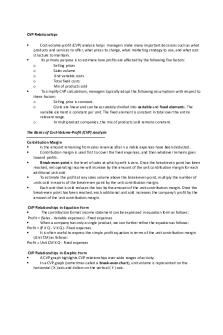CVP guide questions PDF

| Title | CVP guide questions |
|---|---|
| Author | Ellah Madis |
| Course | Bachelor of Science In Accountancy |
| Institution | University of San Jose-Recoletos |
| Pages | 20 |
| File Size | 1.3 MB |
| File Type | |
| Total Downloads | 129 |
| Total Views | 349 |
Summary
University of San Jose – Recoletos School of Business and Management Accountancy and Finance Department Strategic Business Analysis Mr. Jun Brian Alenton CPA, CMA, CAT, RCA, MICB, MBAModule 3Cost-Volume-Profit and Breakeven AnalysisExercisesA. Breakeven Point, Margin of SafetyPM operate a bed and br...
Description
University of San Jose – Recoletos School of Business and Management Accountancy and Finance Department Strategic Business Analysis Mr. Jun Brian Alenton CPA, CMA, CAT, RCA, MICB, MBA
Module 3 Cost-Volume-Profit and Breakeven Analysis Exercises A. Breakeven Point, Margin of Safety PM operate a bed and breakfast hotel in a resort area in the Smoky Mountains. Depreciation on the hotel is . Kelly employs a maintenance person at an annual salary of er year and a cleaning person at an annual salary of 0 per year. Real estate taxes are per year. The rooms rent at an average price of per person per night including breakfast. Other costs are laundry service at per person per night and the cost of food which is per person per night. ) Determine the number of
and the
e Kelly needs to
n using the
If the current level of rentals is by what percentage can rentals decrease before Kelly has to worry about having a net loss? Kelly is considering upgrading the breakfast service to attract more business and increase prices. This will cost an per person per night. Kelly feels she can increase the room rate to per night. Determine the nt s and the lly needs to break even if the changes are made.
Module 3
ACCTG202
Page 1 of 16
B. Required Sales considering Desired Profit Grange Company had a net loss of P100,000 in 2001 when the selling price per unit was P20, the variable costs per unit were P12, and the fixed costs were P400,000. Management expects per unit data and total fixed costs to be the same in 2002. Management has set a goal of earning net income of P100,000 in 2002. a) Compute the units sold in 2001. b) Compute the number of units that would have to be sold in 2002 to reach management’s desired net income level. c) Assume that Grange Company sells the same number of units in 2002 as they did in 2001. What should the selling price have to be in order to reach the target net income?
Module 3
ACCTG202
Page 2 of 15
C. Breakeven Point, Required Sales considering Desired Profit Rush Company developed the following information for its product: Sales price Variable cost Contribution margin Total fixed costs
Per Unit P90 63 P27 P1,350,000
1. 2. What is the total sales that must be generated for the company to earn a profit of P60,000? 3. If the company is presently selling 75,000 units, but plans to spend an additional P135,000 on an advertising program, how many must the company sell to earn the same net income it is now making? 4. Using the original data in the problem, compute a new break-even point in units if the unit sales price is increased 20%, unit variable cost is increased by 10%, and the total fixed costs are increased by P198,000.
Module 3
ACCTG202
Page 3 of 15
D. Breakeven Point – Multiple Products PM Corporation produces three products, P, W, and M, with the following related data: Unit sales price Unit variable costs Sales mix in units Total fixed costs, P800,000 1. 2. 3. 4.
P P200 120 2
W P50 20 5
M P120 90 3
Determine the weighted average unit contribution margin. Determine the composite BEP in units and allocation of composite BEP. How much is the composite BEP in pesos? How much is the number of units to be sold if the firm wants a profit of P40,000?
Module 3
ACCTG202
Page 4 of 15
E. Operating Leverage PM discloses the following data relative to its product MP for its 2016 operations: Contribution margin (40,000 units x P50) Total fixed costs and expenses CMR Ratio
2,000,000 1,200,000 40%
1. What is the DOL? 2. What would be the percentage increase in profit before tax if sales are expected to increase by 40% in 2017? 3. If the firm wants to increase its DOL to 4.0 in 2017, how much should be the needed increased in fixed costs assuming the contribution margin remains the same?
Module 3
ACCTG202
Page 5 of 15
F. PM has decided to introduce a new product. The new product can be manufactured by wither a fully-automated process or a semi-automated process. The manufacturing process will not affect the quality of the product. The estimated unit manufacturing costs by the two methods follow:
Materials Direct labor Variable Fixed Overhead
Fullyautomated 5 6 3
Semiautomated 6 7 4
Directly traceable incremental fixed overhead is expected to be if the process is chosen and if the is chosen. The company’s Market Research Department has recommended an introductory of Regardless of the manufacturing process chosen, the are estimated to be per year plus per each unit sold. 1. Calculate the estimated breakeven point for the new product in annual units of sales if the company uses the: a. Fully-automated manufacturing process b. Semi-automated manufacturing process 2. Determine the annual unit sales volume at which the choice between the two manufacturing processes would not make a difference.
Module 3
ACCTG202
Page 6 of 15
Multiple Choice - Theories 1. To which function of management is CVP analysis most applicable? A. Planning B. Organizing C. Directing D. Controlling 2. The term contribution margin is best defined as the: A. difference between fixed costs and variable costs. B. difference between revenue and fixed costs. C. amount available to cover fixed costs and profit. D. amount available to cover variable costs. 3. Firms A. B. C. D.
with a high degree of operating leverage: will have a more significant shift income as sales volume changes have lower fixed costs have low contribution margin ratios are less dependent on volume to add profits
4. In multiproduct situations, when sales mix shifts toward the product with the highest contribution margin, then: A. total revenues will decrease B. breakeven quantity will decrease C. total contribution margin will decrease D. operating income will decrease 5. At the break-even point A. net income will increase by the unit contribution margin for each additional item sold above break-even. B. the total contribution margin changes from negative to positive C. fixed costs are greater that contribution margin D. the contribution margin ratio begins to increase 6. Which of the following is not an assumption underlying C-V-P analysis? A. The behaviour of total revenue is linear. B. Unit variable expenses remain unchanged as activity varies. C. Inventory levels at beginning and end of the period are the same. D. The number of units produced exceeds the number of units sold. 7. Operation leverage is high in firms with A. a small proportion of fixed costs, a high proportion of variable costs, and the resulting high contribution margin per unit. B. a small proportion of fixed costs, a high proportion of variable costs, and the resulting low contribution margin per unit. C. a high proportion of fixed costs, a small proportion of variable costs, and the resulting low contribution margin per unit. D. a high proportion of fixed costs, a small proportion of variable costs, and the resulting high contribution margin per unit.
8. With respect to fixed costs, C-V-P analysis assumes that fixed cost: A. per unit remains constant as volume changes B. in total remains constant from one period to the next C. in total varies directly with volume D. in total remains constant across changes in volume Module 3
ACCTG202
Page 7 of 15
9. As projected net income increases the A. degree of operating leverage declines B. margin of safety stays constant C. break-even point goes down D. contribution margin ratio goes up 10. A company’s breakeven point in sales pesos may be affected by equal percentage increases in both selling price and variable cost per unit (assume all other factors are equal within the relevant range). The equal percentage changes in selling price and variable cost per unit will cause the breakeven point in sales pesos to A. decrease by less than the percentage increase in selling price. B. decrease by more than the percentage increase in the selling price. C. remain the same. D. increase by more than the percentage increase in selling price. 11. A company increased the selling price for its product from P1.00 to P1.10 a unit when total fixed cost increased from P400,000 to P480,000 and variable cost per unit remained unchanged. How would these changes affect the breakeven point? A. The breakeven point in units would be increased. B. The breakeven point in units would be decreased. C. The breakeven point in units would remain unchanged. D. The effect cannot be determined from the information given. 12. On January 1, 2007, Incremental Company increased its direct labor wage rates. All other budgeted costs and revenues were unchanged. How did this increase affect incremental Company’s budgeted break-even point and budgeted margin of safety? Budgeted Expected Break-even Point Margin of Safety A. Increase Increase B. Increase Decrease C. Decrease Decrease D. Decrease Increase 13. A very high degree of operating leverage (DOL) indicates that a firm: A. has high fixed costs. B. has a high net income. C. has high variable costs. D. is operating at a level close to its breakeven point 14. If the company raises its target peso profit, its A. break-even point rises. B. fixed costs increase. C. required total contribution margin increases. D. selling price rises. 15. A Cost-Volume-Profit graph contains a “Area of Loss” and an “Area of Profitability”. Which of the following best explains the difference between the two points on the graph? A. The area of loss represents the difference between Sales and Variable Cost B. The area of loss begins with the concept that fixed costs have to be recovered prior to sales contributing to profit
C. The area of profit represents the difference between Sales and Variable Cost. D. The area of profit begins with the concept that no company would have any level of sales below the break-even point.
Module 3
ACCTG202
Page 8 of 15
16. Which of the following best describes the impact of selling more units? A. The increase in sales volume increases total variable cost B. The increase in sales volume means an increase in total fixed cost C. The increase in sales increases contribution margin, causing net income to decrease D. The increase in sales increases contribution margin per unit causing the break-even point to decrease. 17. Assuming a company has net income, which of the following statements is true regarding the contribution margin per unit? A. It will decrease as the number of units sold increases. B. It will decrease as the number of units sold decreases C. It indicates the amount that net income will increase with the sale of each additional unit D. It indicates the amount that variable costs will decrease with the sale of each additional unit. 18. A company with a high level of operating leverage will: A. experience fewer fluctuations in income as sales fluctuate than a company with a low level of operating leverage B. experience wider fluctuations in income as sales fluctuate than a company with a low level of operating leverage C. earn higher profits than a company with a low level of operating leverage D. earn lower profits than a company with a low level of operating leverage 19. A relatively low margin of safety ratio for a product is usually an indication that the product: A. is losing money B. has a high contribution margin C. is riskier than higher margin of safety products D. is less risky than higher margin of safety products 20. In CVP analysis, when the number of units changed, which one of the following will remain the same? A. Total sales revenues B. Total variable costs C. Total fixed costs D. Total contribution margin 21. Which of the following would not affect the breakeven point? A. Number of units sold. B. Variable cost per unit. C. Total fixed costs D. Sales price per unit 22. The most likely strategy to reduce the breakeven point would be to A. increase both the fixed costs and the contribution margin B. decrease both the fixed costs and the contribution margin C. decrease the fixed costs and increase the contribution margin D. increase the fixed costs and decrease the contribution margin
Module 3
ACCTG202
Page 9 of 15
23. A company’s breakeven point in peso sales may be affected by equal percentage increases in both selling price and variable cost per unit (assume all other factors are equal within the relevant range). The equal percentage changes in selling price and variable cost per unit will cause the breakeven point in peso sales to A. Decrease by less than the percentage increase in selling price. B. Decrease by more than the percentage increase in the selling price. C. Increase by less than the percentage increase in the selling price. D. Remain unchanged. 24. If a company is operating at a loss, A. fixed costs are greater than sales B. selling price is lower than the variable cost per unit C. selling price is less than the average total cost per unit D. fixed cost per unit is greater than variable cost per unit 25. Which of the following decreases per-unit contribution margin the most for a company that is currently earning a profit? A. A 10% decrease in selling price B. A 10% increase in variable cost per unit C. A 10% increase in fixed costs D. A 10% increase in fixed cost per unit. 26. Introducing income taxes into cost-volume-profit analysis A. raises the break-even point. B. lowers the break-even point. C. increases unit sales needed to earn a particular target profit D. decreases the contribution margin percentage 27. A cost-volume-profit graph reflects relationships A. that are expected to hold over the relevant range. B. of results over the past few years. C. that the company’s managers would like to have happen. D. likely to prevail for the industry. 28. If the sales mix shifts toward higher contribution margin products, what would happen to the break-even point? A. decreases. B. increases. C. remains constant. D. it is impossible to tell without additional information. 29. In order for the break-even computation to be meaningful to management, sales mix should be computed using the A. expected mix B. least desirable mix C. most desirable mix D. traditional mix 30. Spreadsheets are used in financial modelling. Once you have set up the basic formula, it is easy to determine the effect of changing price, costs, volume amounts, or any other variable deemed
important to the analysis. This analysis is called A. variable analysis B. fixed analysis C. mixed analysis D. “what if” analysis Module 3
ACCTG202
Page 10 of 15...
Similar Free PDFs

CVP guide questions
- 20 Pages
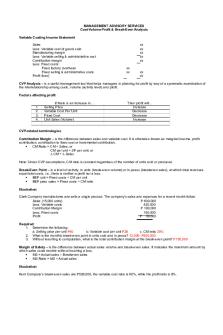
CVP Analysis - CVP
- 9 Pages
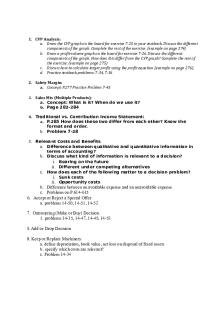
CVP - Chapter 6 on CVP
- 2 Pages

06 CVP Relationships
- 51 Pages

CVP Drill
- 4 Pages

MAS CVP Reviewer
- 26 Pages

COM 316 Chapter 7: CVP
- 10 Pages
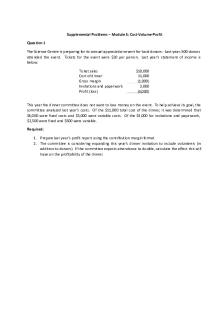
Supplemental Problems CVP up
- 5 Pages

Chapter 22 - CVP Analysis
- 52 Pages
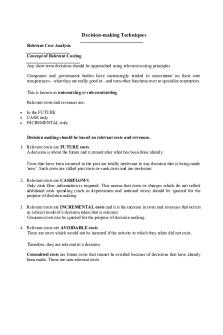
05-Relevant Costing & CVP
- 21 Pages
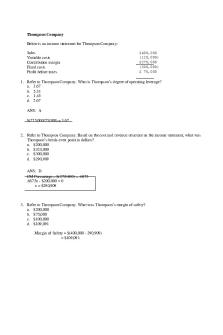
4.5 CVP3 - CVP 3 answers?
- 4 Pages

Additional Practices for CVP
- 11 Pages

CVP Excel exercise 1
- 2 Pages
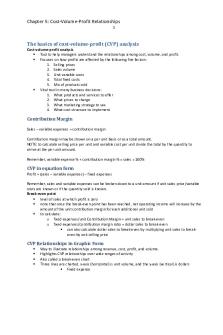
CVP Relationships Notes
- 4 Pages

4.1 cvp2 - CVP Analysis
- 3 Pages
Popular Institutions
- Tinajero National High School - Annex
- Politeknik Caltex Riau
- Yokohama City University
- SGT University
- University of Al-Qadisiyah
- Divine Word College of Vigan
- Techniek College Rotterdam
- Universidade de Santiago
- Universiti Teknologi MARA Cawangan Johor Kampus Pasir Gudang
- Poltekkes Kemenkes Yogyakarta
- Baguio City National High School
- Colegio san marcos
- preparatoria uno
- Centro de Bachillerato Tecnológico Industrial y de Servicios No. 107
- Dalian Maritime University
- Quang Trung Secondary School
- Colegio Tecnológico en Informática
- Corporación Regional de Educación Superior
- Grupo CEDVA
- Dar Al Uloom University
- Centro de Estudios Preuniversitarios de la Universidad Nacional de Ingeniería
- 上智大学
- Aakash International School, Nuna Majara
- San Felipe Neri Catholic School
- Kang Chiao International School - New Taipei City
- Misamis Occidental National High School
- Institución Educativa Escuela Normal Juan Ladrilleros
- Kolehiyo ng Pantukan
- Batanes State College
- Instituto Continental
- Sekolah Menengah Kejuruan Kesehatan Kaltara (Tarakan)
- Colegio de La Inmaculada Concepcion - Cebu
